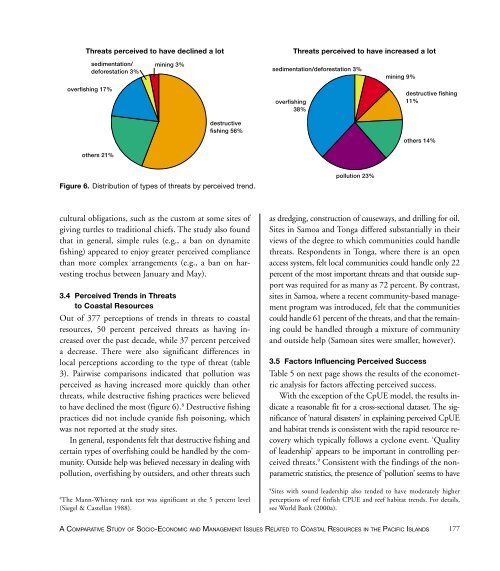Create successful ePaper yourself
Turn your PDF publications into a flip-book with our unique Google optimized e-Paper software.
Threats perceived to have declined a lot<br />
Threats perceived to have increased a lot<br />
sedimentation/<br />
deforestation 3%<br />
mining 3%<br />
sedimentation/deforestation 3%<br />
mining 9%<br />
overfishing 17%<br />
overfishing<br />
38%<br />
destructive fishing<br />
11%<br />
destructive<br />
fishing 56%<br />
others 14%<br />
others 21%<br />
Figure 6. Distribution <strong>of</strong> types <strong>of</strong> threats by perceived trend.<br />
pollution 23%<br />
cultural obligations, such as the custom at some sites <strong>of</strong><br />
giving turtles to traditional chiefs. The study also found<br />
that in general, simple rules (e.g., a ban on dynamite<br />
fishing) appeared to enjoy greater perceived compliance<br />
than more complex arrangements (e.g., a ban on harvesting<br />
trochus between January and May).<br />
3.4 Perceived Trends in Threats<br />
to Coastal Resources<br />
Out <strong>of</strong> 377 perceptions <strong>of</strong> trends in threats to coastal<br />
resources, 50 percent perceived threats as having increased<br />
over the past decade, while 37 percent perceived<br />
a decrease. There were also significant differences in<br />
local perceptions according to the type <strong>of</strong> threat (table<br />
3). Pairwise comparisons indicated that pollution was<br />
perceived as having increased more quickly than other<br />
threats, while destructive fishing practices were believed<br />
to have declined the most (figure 6). 8 Destructive fishing<br />
practices did not include cyanide fish poisoning, which<br />
was not reported at the study sites.<br />
In general, respondents felt that destructive fishing and<br />
certain types <strong>of</strong> overfishing could be handled by the community.<br />
Outside help was believed necessary in dealing with<br />
pollution, overfishing by outsiders, and other threats such<br />
8<br />
The Mann-Whitney rank test was significant at the 5 percent level<br />
(Siegel & Castellan 1988).<br />
as dredging, construction <strong>of</strong> causeways, and drilling for oil.<br />
Sites in Samoa and Tonga differed substantially in their<br />
views <strong>of</strong> the degree to which communities could handle<br />
threats. Respondents in Tonga, where there is an open<br />
access system, felt local communities could handle only 22<br />
percent <strong>of</strong> the most important threats and that outside support<br />
was required for as many as 72 percent. By contrast,<br />
sites in Samoa, where a recent community-based management<br />
program was introduced, felt that the communities<br />
could handle 61 percent <strong>of</strong> the threats, and that the remaining<br />
could be handled through a mixture <strong>of</strong> community<br />
and outside help (Samoan sites were smaller, however).<br />
3.5 Factors Influencing Perceived Success<br />
Table 5 on next page shows the results <strong>of</strong> the econometric<br />
analysis for factors affecting perceived success.<br />
With the exception <strong>of</strong> the CpUE model, the results indicate<br />
a reasonable fit for a cross-sectional dataset. The significance<br />
<strong>of</strong> ‘natural disasters’ in explaining perceived CpUE<br />
and habitat trends is consistent with the rapid resource recovery<br />
which typically follows a cyclone event. ‘Quality<br />
<strong>of</strong> leadership’ appears to be important in controlling perceived<br />
threats. 9 Consistent with the findings <strong>of</strong> the nonparametric<br />
statistics, the presence <strong>of</strong> ‘pollution’ seems to have<br />
9<br />
Sites with sound leadership also tended to have moderately higher<br />
perceptions <strong>of</strong> reef finfish CPUE and reef habitat trends. For details,<br />
see World Bank (2000a).<br />
A COMPARATIVE STUDY OF SOCIO-ECONOMIC AND MANAGEMENT ISSUES RELATED TO COASTAL RESOURCES IN THE PACIFIC ISLANDS<br />
177


















